
David Lyall: Brave Antarctic explorer
David Lyall was a Scottish-born explorer aboard the HMS Terror in 1839 when the ship braved perilous conditions and ventured into the unknown.
10 Jul 2023
David Lyall was a Scottish-born explorer aboard the HMS Terror in 1839 when the ship braved perilous conditions and ventured into the unknown.
10 Jul 2023
Historian Jo Woolf, writer in Residence for the Royal Scottish Geographical Society, tells the story of David Lyall - a Scottish-born explorer who was onboard HMS Terror in 1839 as the ship braved perilous conditions and ventured into the unknown.
At 100 Princes Street we will pay homage to Edinburgh's rich history and take inspiration from the explorers who put 100 Princes Street on the map. In design, our teams will look to create a 'sense of place', working with local artisans to create bespoke pieces and feature a mural honouring the adventures of several great Scottish explorers by Croxford & Saunders. Read more about this rich history below.
In October 1839, two ships set sail from London on an outrageously daring expedition. Their destination was the Antarctic, a region so little known that no one was even sure that it was a continent. There were no maps, no sea charts, and no means of communication with the outside world; and the ships were powered by sail, with no engines to propel them quickly out of danger.
HMS Erebus and HMS Terror were naval warships that had been freshly converted and equipped for a scientific venture led by one of Britain's most capable naval officers, Sir James Clark Ross. The primary aim of the expedition was to measure the magnetic field of the Earth. In 1831, Ross had taken part in an Arctic expedition that had located the North Magnetic Pole, and six years later, he was hoping to discover its equivalent in the south. He was also intending to measure terrestrial magnetism at a series of specially-constructed stations along his route.
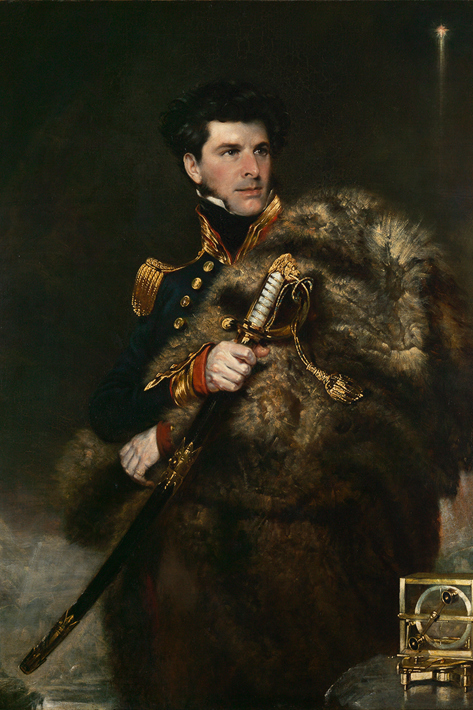
Sir James Clark Ross (portrait by John R Wildman, 1834)
In between times, studies would be made of the climate, geology, zoology and vegetation of lands they encountered, and measurements taken of ocean currents, depths and tides. All these duties, in addition to the rigorous discipline in place aboard ship, would ensure that everyone was kept active, both mentally and physically. The officers and crew - 64 on each vessel - would be away from home for four years. Except when they put into a port, the ships would be their home and their entire world.
On board the Terror as she made her way out of the Thames and into the English Channel was a young man called David Lyall. Born in Auchenblae in the old county of Kincardine (now part of Aberdeenshire) to a family of farmers and millers, he had qualified as a Licentiate of the Royal College of Surgeons in Edinburgh at the age of 21. A year later, having joined the Royal Navy, he was invited to use his newly acquired medical skills as assistant surgeon on this extraordinary voyage.
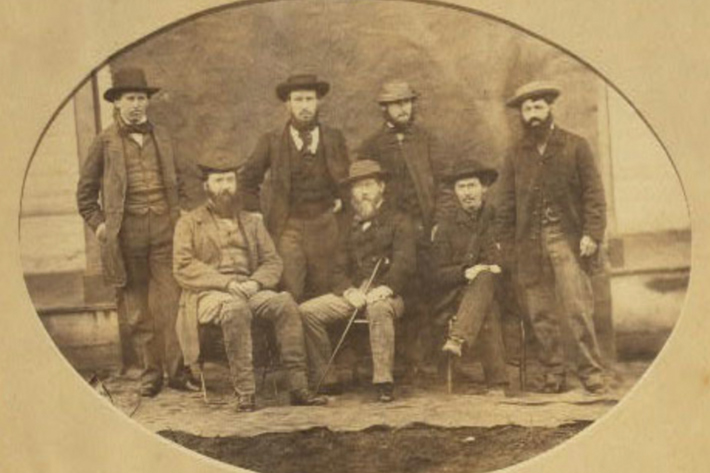
Lyall, seated, far left, pictured with members of a boundary survey team in USA (1858)
Lyall's counterpart on the Erebus was the 22-year-old Joseph Dalton Hooker. Like Lyall, he was fresh out of medical school and eager for adventure. Lyall and Hooker were botanists as well as surgeons: plant extracts were essential components of all kinds of medicines, so the study of botany was an integral part of a physician's education. Aside from their medical duties, they were eager to go ashore on plant-hunting expeditions, knowing that the discovery of new species was almost guaranteed.
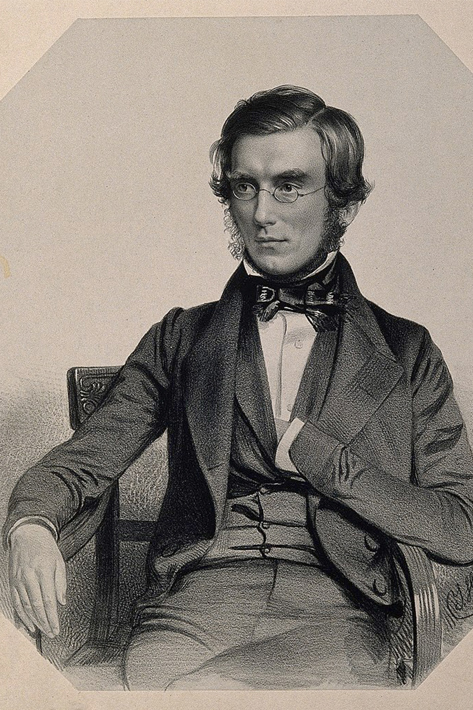
Joseph Dalton Hooker (portrait by T H Maguire, 1851)
Swinging south down the Atlantic Ocean, the ships called in at Madeira, the Canary Islands and St Helena before arriving in Simonstown, South Africa, in March 1840. After a stay of about three weeks they continued their voyage, battling ferocious storms in the Southern Ocean. On one occasion, Ross reported that the crews had 'spent the night in great anxiety, and in momentary expectation that our [smaller] boats would be washed away by some of the broken waves that fell on board, or that from the frequent shocks the ship sustained… we should lose some of the masts.'
In these appalling conditions, Ross still wanted to go ashore and explore the remote southern islands that they encountered. Arriving off the small archipelago known as the Crozet Islands, he found the weather was too wild for his boats to land, which was a disappointment to Lyall and Hooker; however, a party of elephant seal hunters who had been stranded on the islands came out to the Erebus. To the disappointment of the castaways, they were not rescued - Ross only had orders to re-supply them with food, and gave them a letter from their employer - but they must have been interviewed by Hooker and Lyall, because Hooker complained that they 'elicited no satisfactory information as to whether the valuable 'Cabbage' of [Kerguelen] island also inhabits the Crozet group.'
For David Lyall, whose grandfather, William, had made a name for himself in Kincardineshire with his pioneering experiments in growing turnips, it might have seemed slightly surreal to be obsessing about another vegetable at the opposite end of the globe. However, the plant known as the Kerguelen cabbage had already been noted by the explorer James Cook on his voyages in 1776, and there was a good reason why Lyall and Hooker were keen to find out more: Cook believed it to be a miracle cure for scurvy, and although it had been named Pringlea after Sir John Pringle, who wrote a paper on the disease, it had yet to be properly classified as a species.
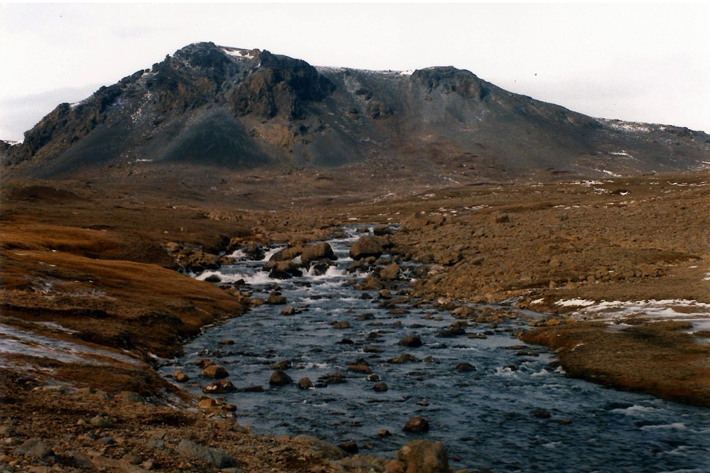
The volcanic landscape of the Kerguelen Islands. These small islands are among the most isolated places on Earth, lying some 1,800 nautical miles from Madagascar.
It was therefore with great excitement that Hooker and Lyall presently set foot on Grande Terre, the largest of the Kerguelen Islands. They didn't have to search for long. Hooker wrote: 'The Pringlea is exceedingly abundant over all parts of the island… but only attaining its usually large size close to the sea, where it is invariably the first plant to greet the voyager.' Hooker lost no time in naming the plant Pringlea antiscorbutica (its second name meaning 'antidote to scurvy'). While the botanists were busy examining and drawing specimens in their laboratories, the cooks on each ship were spooning daily servings of this new 'superfood' onto dinner plates alongside the men's beef and pork and even adding it to their pea soup. They decided that the roots were reminiscent of horseradish, while the leaves tasted of mustard and cress.
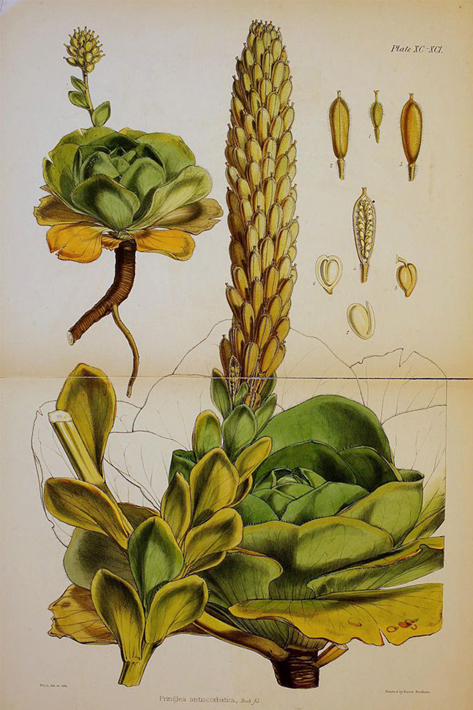
Kerguelen cabbage (Pringlea antiscorbutica) illustrated in Hooker's work, The Botany of the Antarctic Voyage of HM Discovery ships Erebus and Terror in the years 1839-1843 under the Command of Captain Sir James Clark Ross
In the 1800s, the causes of scurvy were poorly understood, so it is easy to see how Kerguelen cabbage was hailed as a miracle cure. In fact, any fresh fruit and vegetables with high Vitamin C content could have been used as a remedy.
The ships stayed at the Kerguelen Islands for two and a half months, while Ross carried out scientific experiments. This was the start of the southern winter, and blizzards whipped across the bleak, volcanic landscape. Most of the crew found it a dreary place, but Hooker and Lyall were in their element. Hooker rejoiced at finding 30 different species in one day, and when he discovered a new genus, endemic to the Kerguelen Islands, he insisted on naming it Lyallii after David Lyall. He wrote: 'This highly curious genus, coming from the most interesting island visited by the Antarctic Expedition, will serve to commemorate in some slight degree the important services rendered to Botany by my zealous friend and co-operator, Dr. Lyall, R.N.'
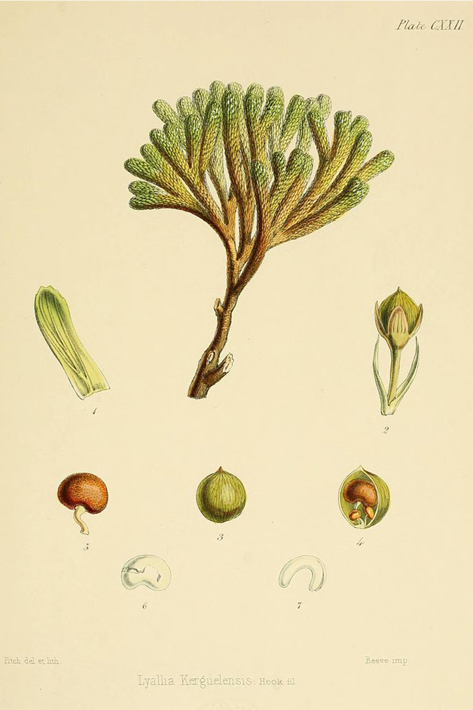
Lyallia kerguelensis, illustrated in Hooker's Botany of the Antarctic
Over-wintering in Tasmania gave the officers and crews a few months of respite and a chance to catch up with letters from home. At that time, Tasmania was a penal colony known as Van Diemen's Land, and the men were given a warm welcome by the Lieutenant Governor, Sir John Franklin. (No one could possibly have known that, in five years' time, Franklin would be taking the Erebus and Terror, newly fitted with engines, in a quest for the Northwest Passage, an expedition from which he would never return.) In November, filled with anticipation, Ross and his men departed for the Antarctic, calling at the Auckland Islands and Campbell Island on the way.
In the Auckland Islands, the botanists were delighted to find 80 species of flowering plants, of which over 50 had not been classified before. In great excitement, Hooker lugged a four-foot-high tree-fern onto the Erebus, to add to his already burgeoning collections. New Year's Day, 1841, saw them crossing the Antarctic Circle and 'splicing the mainbrace' - in other words, toasting themselves with extra rations of rum.
It was a big risk to take sailing ships into the pack-ice, but that is exactly what Ross did. His experience told him that their reinforced bows could withstand the strain, and he followed narrow leads or channels in the ice, pushing his way through when necessary. His courage was rewarded when Erebus and Terror emerged into the clear water of an area now called the Ross Sea, having negotiated some 134 miles of pack ice. Before long, there was a cry of 'Land ahoy!' The expedition had found the first proof that an Antarctic continent existed.
Ross allowed his ships to cruise along the newly-discovered coast, noting prominent features that they passed. He named Victoria Land after Britain's reigning monarch, and then a distinguished list of naval lords and peers of the realm were commemorated in mountain peaks and coastal capes. When they came within sight of two majestic volcanoes, one actively erupting, Ross couldn't resist calling them after his ships: Mount Erebus and Mount Terror. Around the coast of Victoria Land, he named the Lyall Islands in honour of David Lyall, and Cape Hooker after Joseph Dalton Hooker.

The ships with Mount Erebus in the background (illustration by John E Davis, Second Master on Terror)
Presently an extraordinary sight met their eyes. In his account, Ross wrote: 'We perceived a low white line extending from its eastern extreme point as far as the eye could discern.' This line turned out to be a sheer-sided cliff of ice, towering above the ships to a height of 200 feet. They had encountered what is now known as the Ross Ice Shelf, and they were the first to see it. They called it the Great Southern Barrier, because it effectively stopped them from making any kind of progress further south: Ross had to give up his hopes of finding the South Magnetic Pole.
After spending another winter in Tasmania, the ships headed south once again. On the frozen sea, the men indulged in riotous games and a fancy dress ball to greet the New Year of 1842, with the ships' captains enjoying the spectacle from thrones carved out of ice. The Terror's Second Master, John E Davis, wrote to his sister: 'You would have laughed to see the whole of us, with thick overall boots on, dancing, waltzing and slipping about… and the best of it was there was not an ill word the whole time.'
But the Antarctic was about to become very threatening. On 13th March, in the early hours of the morning, a storm blew up which sent Erebus on a crash-course with a colossal iceberg. As the crew grappled wildly with the sails, trying to steer her clear, they realised that the Terror was now heading straight for them. The ships collided and smashed together, breaking some of their masts and tangling their rigging. Miraculously, both vessels escaped from the iceberg through a narrow channel, and hasty repairs were made to the splintered timbers.

Erebus and Terror in the Antarctic (painting by James Wilson Carmichael, 1847)
When the ships returned to Britain in 1843, they brought with them a wealth of scientific observations and natural history specimens. Hooker immediately set about writing an official report of botanical discoveries; in his many descriptions of new species, he repeatedly acknowledged the exertions of his 'indefatigable friend, Dr Lyall.'
In the face of almost overwhelming odds, the success of Ross's expedition was - and still is - nothing less than breathtaking. Seventy years later, in his book, The South Pole, Norwegian explorer Roald Amundsen paid the explorers a heartfelt tribute. He wrote: 'These men were heroes - heroes in the highest sense of the word.'
Footnotes
Between 1847 and 1851, Lyall served as surgeon and naturalist on HMS Acheron, tasked with a survey of New Zealand. He provided an early description of the kakapo, one of its endemic birds, and discovered the white-flowered buttercup, Ranunculus lyallii. When Terror and Erebus were lost in the Arctic on Franklin's last expedition, Lyall went out on one of the many search missions (on HMS Assistance) in an attempt to find them.
Joseph Dalton Hooker succeeded his father, William Jackson Hooker, as Director of Kew Gardens, and enjoyed great renown as a botanist and traveller.
References
Andrew Lyall FLS, David Lyall (1817-1895): Botanical explorer of Antarctica, New Zealand, the Arctic and North America, The Linnean, Vol. 26 (2010)
Sir James Clark Ross, A Voyage of Discovery and Research in the Southern and Antarctic Regions, during the years 1839-43 (1847)
Sir Joseph Dalton Hooker, The Botany of the Antarctic Voyage of HM discovery ships Erebus and Terror in the years 1839-1843, under the command of Captain Sir James Clark Ross…' (1844-47)
Obituary of Lyall by Sir Joseph Dalton Hooker, Geographical Journal, Vol. 5 (1895)
Michael Palin, Erebus: The Story of a Ship (2018)
The British Museum Collection on David Lyall
Roald Amundsen, The South Pole (1912)
Directly facing the city’s famous castle, the careful and lovingly executed renovation and rebirth of 100 Princess Street is eagerly awaited.
